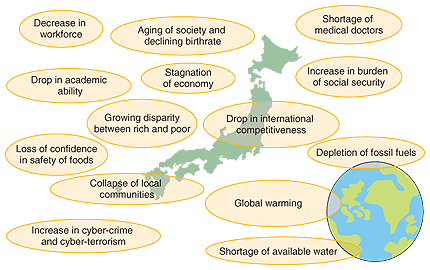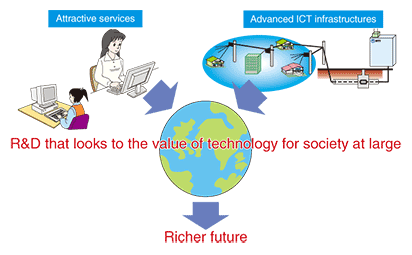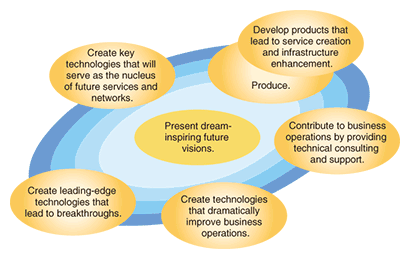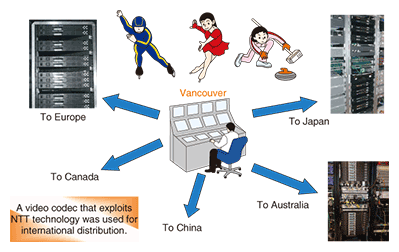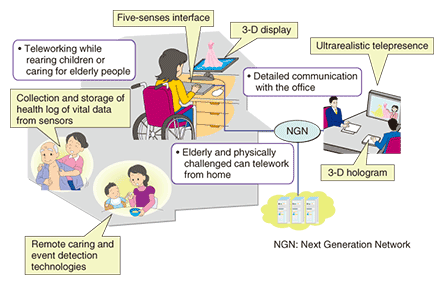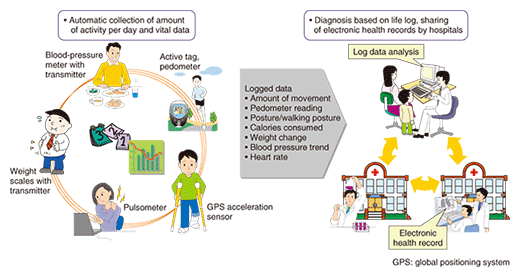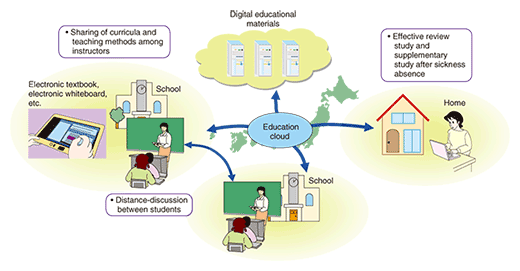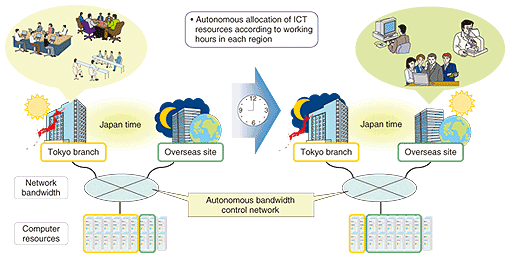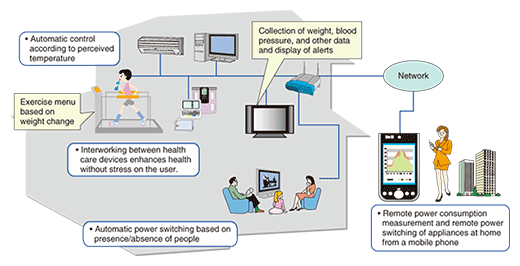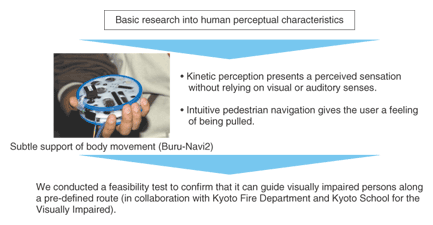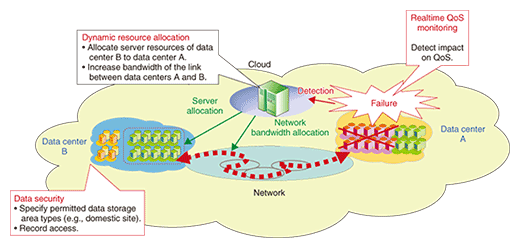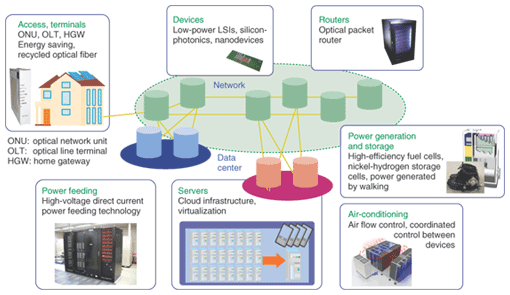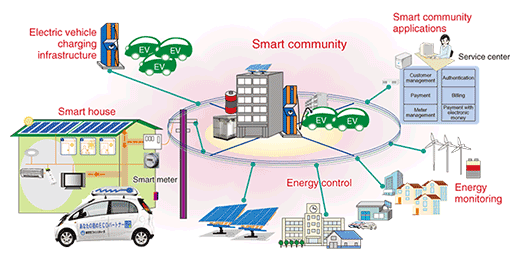 |
|||||
|
|
|||||
|
Special Feature: Keynote Speeches at NTT R&D Forum 2010 Vol. 8, No. 4, pp. 13–23, Apr. 2010. https://doi.org/10.53829/ntr201004sf2 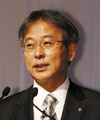 Establishing ICT to Create and Support a Richer FutureAbstractThis article introduces NTT’s R&D activities for developing information and communications technology (ICT) that helps to solve social issues and is friendly to people, society, and the earth. It is based on the keynote address given in Japanese by Hiromichi Shinohara, NTT Senior Vice President, Director of Research and Development Planning Department, at the NTT R&D Forum 2010 held on February 22–24, 2010. 1. Introduction1.1 Development of broadband networksIn Japan, 63% of households now have broadband access, mainly via fiber to the home (FTTH), cable television (CATV), and digital subscriber line (DSL). For more than 30 years, NTT has been undertaking research and development (R&D) in a variety of fields to bring FTTH to reality. In around 2000, about the time when we started providing FTTH service, most people insisted that ADSL (asymmetric DSL) was sufficient. Nevertheless, researchers looked to the future, imagined what would be the best solution, and studied how they could achieve that solution. Thanks to their efforts, FTTH now covers 90% of the populated area in Japan and we can safely say that FTTH facilities are well established throughout Japan. International comparison shows that Japan leads the world in high-speed low-cost broadband services. However, these days there are people who say that the growth in the number of users subscribing to broadband services is slowing down. We believe this is due to the lack of services that only FTTH can provide. It will become important to further exploit broadband services and, in particular, to create new services that take full advantage of FTTH. 1.2 ICT for solving social issuesRecently, there have been increasing manifestations of social issues, such as the aging of society along with a declining birthrate, a decline in children’s academic abilities, and global warming (Fig. 1). The aging of society and declining birthrate necessitates better medical care, support for senior citizens to enable them to participate in social activities, and support for parents by making child-rearing, nursing care, and work compatible. In the field of medical care, there is a growing geographical imbalance in the density of doctors. Therefore, it is important to enable clinics in rural areas to receive support from central hospitals in urban areas, to strengthen preventive medicine in order to reduce the number of visits needed to medical institutes, and to support doctors in acquiring advanced medical technology. In the field of education, schoolchildren’s academic abilities have been declining every year. This decline must be stopped. As for the global environment, emissions of greenhouse gases as a result of human activity tend to exceed nature’s capacity to absorb them. Reducing CO2 emissions to curb the rise in the average temperature of the earth is a global challenge.
Information and communications technology (ICT) is expected to play a significant role in overcoming these social issues. Expectations for ICT in the coming years can be summarized as follows. (1) Support for everyday life and work ICT should shift from being a tool for retrieving information to being one for discreetly presenting information appropriate for a user’s characteristics and current situation and for supporting efforts to improve everyday life and work. (2) Strengthening of international competitiveness ICT should enhance the productivity of enterprises engaged in global business. (3) Promotion of communication ICT should shift from being a tool for sharing information to being one for sharing trust. It should infer people’s feelings and support them in understanding what others are thinking and feeling while overcoming differences in race, sex, generation, culture, and environment. (4) Improvements in the environment ICT should not only reduce its own CO2 emissions but also contribute to the reduction of global CO2 emissions by increasing the efficiency of all aspects of life in society. 1.3 Roles of NTT R&DTo make these expectations for ICT come true, NTT R&D Laboratories not only contributes to the business of the NTT Group by creating attractive services and providing advanced ICT infrastructures, but also undertakes R&D that looks at the value that can be provided to the whole of society in order to achieve a richer future (Fig. 2). We must consider how we can contribute to society and undertake R&D based on our vision for the future. To respond to changes in the market in a timely manner in the face of the multifaceted expansion of technical fields, it is becoming increasingly important to seek open innovation, in which we do not stick to developing everything by ourselves but instead integrate our strengths with those of outside parties. Therefore, it is necessary to consciously separate our role of creating key technologies that will serve as the nucleus of products from our role of developing products themselves. Through the various roles it plays, NTT is committed to contributing to a richer future (Fig. 3).
2. Comprehensive producing activities for creating services and providing advanced infrastructuresLet me introduce some of our comprehensive producing activities for creating services and providing advanced infrastructures. (1) Home ICT platform We are developing a home ICT platform that will enable a variety of home devices and appliances to be connected to the network and new services to be provided. Common functions used by different services, such as the discovery and settings adjustment of home devices and secure remote access to those devices, are implemented on a home gateway and service gateway. This arrangement lets the user use services easily with a high level of confidence in security. The home ICT platform enables service providers to provide new services easily. It also makes it easy for multiple services to work with each other to create entirely new services. In November 2009, together with five other participating companies, we announced that we would conduct a technical verification test of home ICT services on a testbed environment built on a home ICT platform. We will collaborate with service providers to create home ICT services. (2) Digital cinema NTT’s high-security, high-reliability digital cinema technology was used to develop Japan’s first commercial distribution service called PURE CINEMA. It was put into commercial service in 2009. The service exploited NTT’s technology for distributing video content, which requires extremely high security, over the network with sufficient content protection. We are also promoting the use of the digital cinema distribution network for other digital content, including live videos of events, which is often called ODS (other digital stuff or online digital source). (3) Digital signage With a view to expanding the market for digital signage, which presents information via network-connected displays installed outdoors or in shop entrances, NTT began in February 2010 to sell Hikari Signage Series, an inexpensive solutions package designed for offices and small shops. NTT is working on a business implementation of a digital signage platform in order to expand the use of network-connected digital signage. (4) Video codecs A video codec that exploits NTT technology was used to distribute scenes of the Vancouver Olympics to the world (Fig. 4).
3. Dream-inspiring future vision3.1 Vision of a richer future through R&DNTT aims to achieve a caring heart, caring economy, and caring planet. The vision of the future that we are aiming at is a society of 7 billion people around the world connected and able to communicate with each other: a barrier-free society (caring heart) that enables people to conduct worldwide business at any hour with a high level of confidence in security (caring economy) in which eco- and human-friendly ICT services are readily available (caring planet). 3.1.1 Caring heartLife: It will become possible to provide a warm and caring lifestyle in which work, nursing care for the elderly, and child-rearing are compatible with each other. Interfaces providing ultrahigh reality and high operability will become widely used. These will facilitate interactive collaboration between people anytime and anywhere. They will not only enable seniors or physically challenged people to participate in social activities, but also enable younger people engaged in nursing care or child-rearing to continue to work with people in the office (Fig. 5).
Medical care: It will become possible to prevent illness or aid recovery from illness by making records of people’s lives more visible and by enabling medical institutes to work together to improve the health of the people they look after. Patient life logs will automatically gather health data from sensors without requiring conscious effort by the patient, and health records will be transferred to the most appropriate medical institute so that patients receive the best treatment and health advice on the basis of an analysis of their life log data (Fig. 6).
Education: It will become possible to provide high-quality teaching and educational materials so that students can learn effectively in an interesting and enjoyable manner. Educational cloud computing will enable students at different sites to engage in discussions and let instructors at different sites share curricula and teaching know-how so that students can learn more effectively. Review and supplementary study at home will also be more effective (Fig. 7).
3.1.2 Caring economyEnterprises: High flexibility in the allocation of ICT resources will facilitate improvements in global business. The autonomous distribution of ICT resources will automatically optimize the sharing of network bandwidth and computing resources among business sites in different regions of the world. This will lead to dramatic cost reductions and efficiency improvements (Fig. 8).
3.1.3 Caring planetEnvironment: Autonomous interworking between networked home appliances will lead to energy savings and a comfortable way of life. The widespread use of home ICT centered around a home gateway will lead to information devices and home appliances becoming maintenance-free. Autonomous interworking between them will reduce standby power consumption. Automatic control of air-conditioners and lighting linked with body sensors will provide a comfortable atmosphere in the living environment (Fig. 9).
3.2 Directions of technologies that need to be strengthenedThe directions of technologies that need to be strengthened in order to achieve the future vision described above are as follows. At the application level, we will press forward with adaptive ICT services that take account of the user’s situation or mood. In addition, we will pursue a mechanism that raises security, an engineering word, to safety, a psychological word. We will also seek to facilitate the use of ICT so that not only pioneering early-adopters, who know how to fully exploit personal computers, but also a wider spectrum of people will find ICT easy to use. At the network level, we will aim to develop an autonomous ICT infrastructure that responds to a variety of requests quickly. In the field of the environment, we will aim to build new social systems that incorporate ICT and environmental technologies. 3.2.1 Pliant ICT servicesWe will aim to develop adaptive ICT services that take account of the situations and moods of the information senders and receivers so that the services adapt to the particular situation and are user-friendly. For this purpose, we will strengthen our R&D of technology for recognizing the intention and situation of the information sender (understanding of the situation), technology for translating a user’s general request into specific demands by taking account of the user’s generation and cultural background (rephrasing into specific expressions), and technology for displaying or supplementing information in a way that matches the user’s input/output interface (user-friendly conveyance of information). These activities are expected to convey deeper information, which tends to be lacking in virtual communication, and bring about congenial communication in the future. NTT is working on technology for presenting information without relying on only visual or auditory senses (Fig. 10). We have developed a device (called Buru-Navi2) that exploits human perceptual characteristics to generate a feeling of being pulled in a particular direction. This device can be incorporated into a mobile terminal. We have conducted a technical verification test in collaboration with a fire department and a school for the visually impaired to confirm that it can guide visually impaired persons along a pre-defined route and ascertained its validity.
3.2.2 Autonomous ICT infrastructureWith a view to ensuring the continuity of service (making connections always available) and providing services instantly when customers require them (providing connections instantly), we will reinforce our R&D to develop an ICT infrastructure that responds autonomously to various demands, such as customers’ requests and the need to recover quickly from a failure or disaster. An example of our efforts to make an autonomous ICT infrastructure a reality is the high-reliability cloud architecture shown in Fig. 11. We will intensify research on realtime quality-of-service (QoS) monitoring technology, which instantly detects the impact on customers of a degradation in QoS caused by an increase in the traffic load or a failure, and research on technology that dynamically reallocates network bandwidth and server resources in data centers that have spare capacity. In addition, with a view to enhancing data security and addressing customers’ worries about where their data physically resides when they use cloud computing, we will develop technology that lets them specify the types of areas where data may be stored (e.g., a domestic site) according to the attributes of the data and technology for keeping records of who has accessed data even if that data is distributed in a cloud.
3.2.3 Green ICTWe will undertake R&D to develop an ICT infrastructure that contributes to reducing waste in social and economic activities and in the use of resources and to achieving a low-carbon, recycling-oriented society. We believe that it is important to take a two-pronged approach: reducing the CO2 emissions from ICT systems themselves (green of ICT) and reducing the CO2 emissions by society at large through the use of ICT systems (green by ICT). Representative measures taken by NTT for green of ICT are shown in Fig. 12. We are working on optical packet routers, which are intended to dramatically reduce router power consumption by replacing as much conventional electrical processing as possible with optical processing. Although this technology is currently targeted at the core network, we plan to apply it to access networks in the future in order to reduce the power consumed by the entire network. Because of their sheer number, the devices used in access networks and customers’ premises account for a major part of the total power consumed in telecommunications. We will not only reduce the power consumed by each device but also develop systemic innovations to reduce the total power consumption, such as by putting idle devices into sleep mode.
The application of ICT to various human activities can contribute to a reduction in CO2 emissions. The use of ICT can reduce the movement of people and goods and the consumption of goods and can also improve the efficiency of energy usage. ICT can be used to measure the environment and predict future changes in it. For example, to improve energy use efficiency in a smart community, it is important to be able to convey surplus energy bidirectionally in a flexible manner between houses and offices within the community (Fig. 13). NTT can use ICT to integrate various environmental technologies, such as photovoltaic power generation and electric vehicles. We will work with other companies, such as power utility companies, to achieve a smart community.
We are studying environmental impact assessment technology for measuring CO2 emissions in order to make the effects of environmental impact reduction measures readily visible. We are proposing this technology not only within Japan but also in ITU-T (International Telecommunication Union, Telecommunication Standardization Sector) for international standardization. Leading the way in the application of ICT for environmental impact reduction, NTT has announced a Green Office Declaration, which spells out our determination to improve both the energy use at facilities (hardware-like approach) and the awareness and behavior of researchers (software-like approach). In summary, we will press ahead with a number of eco-friendly activities, such as teleworking to reduce human movement, videoconferencing to reduce both human movement and paper consumption, virtualization technology to reduce the number of servers, and visual presentation techniques for demonstrating the environmental impact of our activities to raise awareness and encourage environmentally friendly behavior. NTT has specified a high numerical goal and will disclose every six months the amount by which it has reduced CO2 emissions. 4. Infrastructure upgrading and world-leading research4.1 Network-related R&D for application in business operationsWe are developing technologies to maintain and upgrade nationwide networks, which serve as social infrastructures, on a continuous basis, always keeping an eye on possible global deployment of the developed technologies. In the future, it will be important to reduce network costs (operating and capital expenditure) drastically, simplify network maintenance and operations, reduce power consumption, and enhance the network’s adaptability, flexibility, and expandability. Specifically, we will undertake R&D of technologies that will simplify plant installation work, make facilities maintenance-free, and improve the efficiency of work conducted in the field. We will also develop guidelines for environmentally sensitive procurement. 4.2 Leading-edge researchAiming to become a center of excellence in the world, we will pursue leading-edge research on new technologies and systems that will bring about innovation in society. NTT has achieved several world’s firsts or top-class research results in various fields. In optical transmission, a data transmission rate of 13.5 Tbit/s was achieved on a single optical fiber over a distance of 7200 km (world record for bandwidth times distance). In cryptography theory, NTT regained the world record for prime-factor decomposition, which is the basis of public key encryption security. In quantum information processing, we demonstrated a single element, a 2-quantum-bit arithmetic element, with multifunctional basic operations for the first time in the world. In brain science, we clarified the role of optical brightness in human perception of gloss. 5. Collaboration in R&DWe believe that new value is created through collaboration between researchers in different research phases or different fields. Two examples of successful collaboration are our highly bendable optical fiber [1] and our small-diameter, low-friction indoor optical cable, which can be installed in narrow ducts in multi-dwelling units [2]. The former was the fruit of collaboration between a research group pursuing ideal optical fibers and a commercial development group developing easy-to-handle optical fibers. The latter was developed through collaborative work between a materials research group and an optical cable research group. These examples show the benefits of NTT’s coverage of a wide range of research themes. Therefore, we will encourage collaboration between people in basic research and those in commercial development andĦĦ between people in NTT Laboratories and those in NTT Group companies or external partners. Such collaboration can create value far greater than we can imagine. 6. ConclusionsCommunications has evolved from the telephone-dominated age of telecommunications to the age of information communication and to the age of information sharing. We believe that the next age is the one in which ICT will be integrated with various other fields in life, such as the economy, education, medical care, and the environment to maximize the benefits of ICT in each field. NTT is pursuing leading-edge technologies that will raise communication to a level at which even the feelings (hearts) of people can be conveyed, thereby contributing to the realization of a richer future and the creation of greater new value than we can imagine. References
|
|||||








